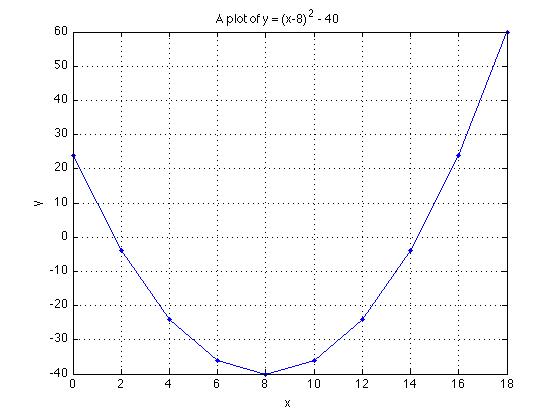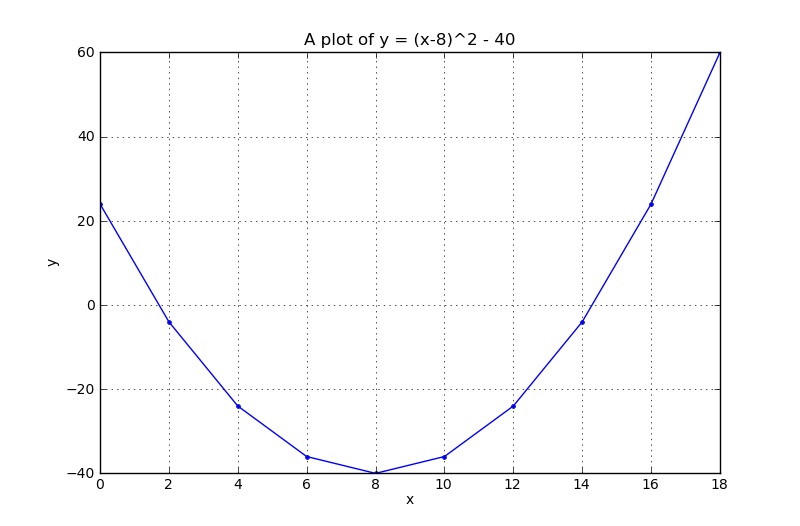Difference between revisions of "Software tutorial/My first program"
m |
m |
||
| (2 intermediate revisions by the same user not shown) | |||
| Line 1: | Line 1: | ||
{{Navigation|Book=Software tutorial|previous=Getting started|current=Tutorial index|next=Loops}} | |||
In this part of the tutorial you are required to create a plot with 10 points (a vector), consisting of the numbers \(x = [0, 2, 4, ... 18] \). Then we will also create a corresponding vector \(y = (x-8)^2 - 40\) and plot these \( (x,y)\) points, pairwise, on a plot. | In this part of the tutorial you are required to create a plot with 10 points (a vector), consisting of the numbers \(x = [0, 2, 4, ... 18] \). Then we will also create a corresponding vector \(y = (x-8)^2 - 40\) and plot these \( (x,y)\) points, pairwise, on a plot. | ||
| Line 26: | Line 28: | ||
'''Note''': that we must use <tt>.^</tt> to calculate the exponent. If you just write <tt>^</tt> by itself, MATLAB will assume you want to calculate the matrix exponent, which is defined quite differently. In fact, any '''element-by-element''' calculation must use the "." notation to tell MATLAB ''not'' to use its default '''matrix''' calculations. | '''Note''': that we must use <tt>.^</tt> to calculate the exponent. If you just write <tt>^</tt> by itself, MATLAB will assume you want to calculate the matrix exponent, which is defined quite differently. In fact, any '''element-by-element''' calculation must use the "." notation to tell MATLAB ''not'' to use its default '''matrix''' calculations. | ||
For example, use <tt>.*</tt> for element-by-element matrix multiplication. If you are bit rusty on this concept, we recommend you read page 4 and 5 of [[Media:MATLAB_primer.pdf | Dr. Mhaskar's | For example, use <tt>.*</tt> for element-by-element matrix multiplication. If you are bit rusty on this concept, we recommend you read page 4 and 5 of [[Media:MATLAB_primer.pdf | Dr. Mhaskar's MATLAB primer]]. | ||
| width="50%" valign="top" | | | width="50%" valign="top" | | ||
| Line 33: | Line 35: | ||
<syntaxhighlight lang="python"> | <syntaxhighlight lang="python"> | ||
import numpy as np | import numpy as np | ||
from | from matplotlib.pylab import * | ||
>>> x = np.array([0, 2, 4, 6, 8, 10, 12, 14, 16, 18]) | >>> x = np.array([0, 2, 4, 6, 8, 10, 12, 14, 16, 18]) | ||
| Line 85: | Line 87: | ||
<syntaxhighlight lang="python"> | <syntaxhighlight lang="python"> | ||
import numpy as np | import numpy as np | ||
from | from matplotlib.pylab import * | ||
</syntaxhighlight> | </syntaxhighlight> | ||
''Advanced topic:''The reason for <tt>import</tt> is due to a technical issue related to [http://bytebaker.com/2008/07/30/python-namespaces/ Python namespaces] --> | ''Advanced topic:''The reason for <tt>import</tt> is due to a technical issue related to [http://bytebaker.com/2008/07/30/python-namespaces/ Python namespaces] --> | ||
Latest revision as of 21:12, 7 February 2017
In this part of the tutorial you are required to create a plot with 10 points (a vector), consisting of the numbers \(x = [0, 2, 4, ... 18] \). Then we will also create a corresponding vector \(y = (x-8)^2 - 40\) and plot these \( (x,y)\) points, pairwise, on a plot.
| MATLAB | Python |
|---|---|
|
There are several ways we can create our vector \(x\) in MATLAB. >> x = [0 2 4 6 8 10 12 14 16 18];
>> x = [0, 2, 4, 6, 8, 10, 12, 14, 16, 18];
>> x = linspace(0, 18, 10); % easiest method
>> x
x =
0 2 4 6 8 10 12 14 16 18
Now create the corresponding \(y\)-vector using MATLAB's ability to do vector operations. We can write >> y = (x-8).^2 - 40;
>> y
y =
24 -4 -24 -36 -40 -36 -24 -4 24 60
Note: that we must use .^ to calculate the exponent. If you just write ^ by itself, MATLAB will assume you want to calculate the matrix exponent, which is defined quite differently. In fact, any element-by-element calculation must use the "." notation to tell MATLAB not to use its default matrix calculations. For example, use .* for element-by-element matrix multiplication. If you are bit rusty on this concept, we recommend you read page 4 and 5 of Dr. Mhaskar's MATLAB primer. |
There are several ways we can create our vector \(x\) in Python. import numpy as np
from matplotlib.pylab import *
>>> x = np.array([0, 2, 4, 6, 8, 10, 12, 14, 16, 18])
>>> x = np.linspace(0, 18, 10) # easiest method
>>> x
array([ 0, 2, 4, 6, 8, 10, 12, 14, 16, 18])
Now create the corresponding \(y\)-vector: >>> y = (x-8) ** 2 - 40
>>> y
array([ 24., -4., -24., -36., -40., -36., -24., -4., 24., 60.])
We raise a variable to a power using the ** notation; the ^ operator means something else in Python. |
Key difference
- In MATLAB, everything is a matrix calculation, by default.
- In Python's NumPy library (numpy), everything is an element-by-element calculation, by default.
Finally, we are ready to plot these \( (x,y)\) points. Notice that the code is nearly identical.
| MATLAB | Python |
|---|---|
plot(x, y, '.-')
grid on
xlabel('x')
ylabel('y')
title('A plot of y = (x-8)^2 - 40')
|
plot(x, y, '.-')
grid('on') # <--- it is a function in Python, so add ()
xlabel('x')
ylabel('y')
title('A plot of y = (x-8)^2 - 40')
|

